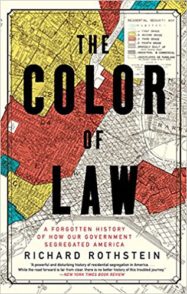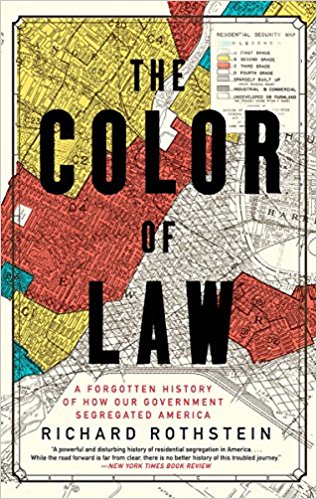–by David Turnoy —
Have you ever heard any statistics on how little wealth black people in this country have compared to whites? The usual ratio is that whites have about 10 times the wealth of blacks. Each of us is then left to wonder why that is, and if we are left to speculation and fail to do the research, we might come up will all manner of ideas. It is important to know that individual wealth is most often a factor of owning a house. We might assume that discrimination by various business entities and by private individuals has been responsible for preventing black home ownership. Even Chief Justice John Roberts of the Supreme Court, writing in a recent court opinion, assumed that residential segregation was mostly created by private choices.
And while private action played a part, the most surprising thing to me is that government policy is in large part responsible. Richard Rothstein has written a compelling book entitled The Color of Law: A Forgotten History of How Our Government Segregated America, and I found this information so important and interesting that I felt it worthwhile to share.
We all know that legally slavery was ended by the 13th Amendment at the end of the Civil War. But in reality, many newly freed slaves had no alternative after the war for making a living other than continuing to work for their former owners. It was set up that the former owner would grant the black worker a plot of land on which to work in exchange for a share of the crop, hence the name “sharecropper”. But the owner kept the books, so somehow it always seemed to happen that after all the deductions for supplies were made, the black worker owed more after the harvest than before. In this way southern blacks continued to be kept down.
Industrial jobs for war production during both world wars pulled millions of southern blacks west and north. We non-southerners like to think that the rest of the country does not experience racism and discrimination, but of course that is not true. And that is where this book tells the true story.
In many cities outside the South, neighborhoods were integrated before government got involved. But government policies provided for racially separate public housing, promoting segregated neighborhoods. The federal government urged suburbs to adopt exclusionary zoning laws, which led to white flight out of the urban areas. The government’s FHA program, responsible for helping so many people purchase housing, could have been restricted only to integrated working class suburbs, but the FHA was fine with promoting segregation. State courts ordered eviction of African American homeowners in neighborhoods where homeowners association rules prevented black people from buying, when the courts could have ordered such restrictions unconstitutional. Churches, universities, and hospitals could have faced loss of their tax-exempt status for promoting restrictive covenants, but the government chose not to sanction these entities. When mob violence erupted in situations where African Americans moved into previously white neighborhoods, rather than arresting these white perpetrators of violence, police encouraged them.
State real estate commissions could have denied licenses to brokers who claimed an “ethical” obligation to impose segregation, but these commissions chose not to. School boards placed schools and drew attendance boundaries to ensure separation of black and white students. Federal and state highway planners used the building of urban interstates to demolish African American neighborhoods and force their residents deeper into urban ghettos. Government chose not to give African Americans the same labor market rights that others enjoyed. The federal government exploited the racial boundaries it had created in metropolitan areas by spending billions on tax breaks for single family suburban homeowners while failing to spend adequate funds on transportation networks that could bring blacks to job opportunities. Even to this day, federal programs reinforce racial isolation by disproportionately directing low income African Americans who receive housing assistance into segregated neighborhoods that government had previously established.
The first step for all of us is to recognize the fact that our government has done all these things to cause segregation and keep black people from owning homes in integrated neighborhoods. The second step, the author argues, is that because government is largely to blame, it is therefore the obligation of government to remedy this situation. This will not be possible with the current administration, which promotes hatred and division. But once we are able to elect a more rational, humane, compassionate, and responsible government, it will be government’s obligation to remedy the lack of wealth among most African Americans.
The Color of Law was written just last year, and you can find it in the 300 nonfiction section of our local library. One would think that this story would have been out decades ago, that we would have all known the truth of this matter for a long time. But sometimes factors play a role in keeping the truth from being released, so I strongly encourage you to read about this less than stellar part of American history. As my mentor Howard Zinn said, we study the past so that we can make informed decisions today to bring about a better tomorrow.
**If you are reading theOrcasonian for free, thank your fellow islanders. If you would like to support theOrcasonian CLICK HERE to set your modestly-priced, voluntary subscription. Otherwise, no worries; we’re happy to share with you.**









